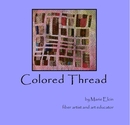When I think about the brain and MRI imaging I always thing of Rorschach blot symmetry. We have bilateral symmetry in our bodies, but not every function in the brain occurs bilaterally. Activity may be localized to one region of the brain in charge of a particular specialty, but even then information passes all over to communicate to the body for movement or the mouth to speak, etc. During our lecture on force networks the idea of paper crumpling came up as something that creates a network of folds and tension points. I wanted to combine these to ideas visually but I didn't want an folds or crumples in my final paper. I started some inkblots on a piece of folded mylar, then transfer printed it to watercolor paper (I might want to try a different, smoother paper as I didn't like the resulting texture in this one) I made bunch of those, adding some watercolor by reprinting over the india ink. I did try crumpling one of my watercolors, but guess what? Thick watercolor paper doesn't like to crumple!! I folded a piece of newsprint in half so my crumple would have bilateral symmetry, then overlaid it on my inkblot and used a seam ripper to poke holes through the papers to transfer the crumple nodes to my painting. Finally I stitched black thread to create edges between the poked nodes. I'm going to take all my experiments with me on Monday to share with the group. Depending on feedback I may continue doing these or maybe continue my polka dot nodes instead.
However, there is still something dissatisfying with these. I'm really only exploring the basics of what a network looks like in these pieces. There is no corresponding data resource that I am trying to visualize. I feel they would be more meaningful if they were connected to a data set in the real world.... But what should that be and how will I find it?
Subscribe to:
Post Comments (Atom)





No comments:
Post a Comment